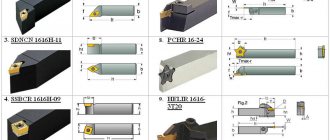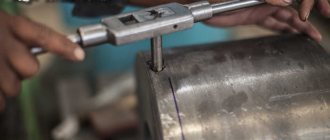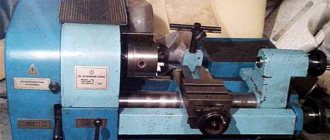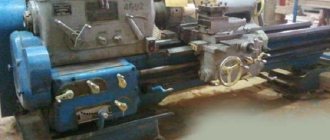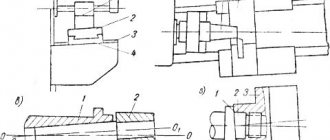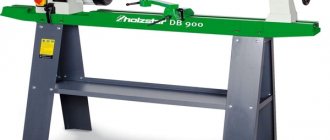About the domestic company Enkor
Enkor-Instrument-Voronezh LLC has been working in the field of manufacturing industrial and instrumental equipment since 1992, during which time it has formed a wide dealer network in all regions of Russia and abroad.
Since 2007, the company has launched production under its own brands, namely, under the auspices of which wood and metalworking machines, as well as a variety of industrial equipment, consumables and components have been united.
The production lines are located in China, all parts for the equipment are manufactured taking into account modern technologies and the most successful technical solutions.
Key technical indicators
The main parameters of the machine can be considered its dimensions and the maximum dimensions of the parts processed on it.
- length – 77 cm;
- height – 33 cm;
- width – 33 cm;
- weight – 37 kg.
The maximum dimensions of parts depend on the place of their processing. At the centers, the machine is capable of working with workpieces up to 30 cm long. The maximum diameter of the workpiece above the bed is 18 cm, and the diameter of the through hole in the spindle is 2 cm. When turning, the maximum depth that the device produces in one pass is 0.2 millimeters. Spindle rotation speed – up to 2500 rpm.
Detailed technical characteristics of the caliper can be found in the table:
Advantages and disadvantages
The advantages of modern Corvette lathes are:
- acceptable build quality of the machines themselves;
- decent quality of components (many of them are made in Europe, but most are made in China);
- direct technical support from the manufacturer, provided through a large network of operating service centers throughout the country.
The disadvantages of Corvette lathes include:
- high engine heating speed on some Corvette lathes, which entails long pauses during work;
- as a result, the service life of some Corvette lathes is not very long.
Description of electrical equipment
The machine operates from a network with a voltage of 220 V, and can be grounded using a special plug. Operating frequency – 50 Hz. To turn on the device, you need to perform a number of simple functions:
- Move the rotation speed regulator to the initial position by turning it counterclockwise.
- Release the emergency shutdown button (move the cover to the side).
- Specify the direction for rotating the chuck.
- Activate rotation by smoothly turning the speed control to the desired speed clockwise.
Remember that the rotation speed depends on the voltage transmitted from the converter! To deactivate the device, turn the speed control counterclockwise all the way or through the emergency shutdown button. You can simply unplug the plug from the socket, but it is safest to use the first option.
Emergency shutdown of the machine should only be used in special situations. The electrical equipment of the device is protected from various power problems using a special fuse, the performance of which must be constantly monitored and changed in time.
Model range for metal and wood
Corvette lathes are divided into three groups: for metal work, wood work and combined (for both types of work).
400
The basic model of the four hundredth series, a budget turning and milling machine with a 400 W motor and two speeds. Processing of parts Ø 180 mm is possible. This lathe has a drawback in the form of plastic gears, which causes breakdowns during operation.
401
It is a copy of the previous model of the lathe, innovations: the ability to cut threads (metric), the use of a more powerful 500 W motor, most of the equipment components are made of steel.
402
It differs radically from the 400 and 401 models by the presence of a 750 W asynchronous motor, a magnetic switch and protective screen, an automatic support feed system and the ability to adjust for processing small-sized workpieces. The maximum processing diameter above the bed is 220 mm.
403
This Corvette lathe is distinguished by the ability to shift the tailstock in a horizontal plane, which increases the distance between centers to 75 centimeters. Like the 402nd model, the 403rd has 6 speed modes and an asynchronous motor.
407
It is universal equipment for performing various types of work (turning, grinding, milling, drilling), since in fact it consists of 403 and 417 models assembled together.
This Corvette lathe is equipped with two motors: asynchronous and commutator, for turning and milling operations, respectively; the basic configuration includes a vice for woodworking.
Large dimensions and weight, which is equal to 150 kg, imply the need for floor installation in a large workshop or in production.
Description
First of all, it’s worth talking about the Corvette-400 screw-cutting lathe. This device is intended for:
- Cutting and boring parts.
- Boring of workpieces in the shape of a cone and cylinder.
- Drilling works.
- Creating metric threads.
- Working with the ends of parts.
In addition, with certain modifications, the machine can work with parts of large diameter or length. This effect is achieved by installing a movable or static rest and return cams.
Turning operations on this device can be carried out off-center (after installing the faceplate). A relatively large number of additional cutting attachments are installed on the machine, which became possible due to the wide range of rotation speeds.
The design of the machine allows it to perform sharpening work with accuracy class “N”. The device is distinguished by its reliability and long period of effective operation compared to other desktop machines. The most acceptable temperature conditions for working with Corvette-400 mechanisms are positive temperatures (from +1 to +38 C), air humidity no more than 80%.
User reviews
Based on user reviews of Corvette lathes, there are significantly more positive impressions than negative ones. The main problems with the machines of this company were at the beginning of its activity; around 2009, most of them were solved. Among the most common complaints is dissatisfaction with relatively weak engines on specific models and individual low-quality parts (much less often).
The opinion that this is a complete copy of SIEG machines, with all their advantages and disadvantages, is considered quite widespread.
In general, we can say that the price/quality ratio of Corvette lathes from the Encor company is not bad; if the selected machine is not planned as the main working tool, operating in two shifts, 7 days a week, then purchasing a Corvette would be a good decision.
Purpose
Lathes for metal processing of the Corvette series are focused on high-quality and in-depth work with metal of various types and properties, and are also suitable for working with wood and plastic. During operation, active surface turning is carried out. Among the list of possible works, the following should be highlighted:
- Various types of turning.
- Trimming the workpiece.
- Cutting metric (inch) threads.
- Drilling of varying complexity, etc.
The scope of application of turning equipment covers all industrial production and servicing of equipment for various purposes. This popularity is based on the excellent performance characteristics of the equipment and a wide range of possible operations. The versatility of the machine and the ability to operate from a standard outlet open up possibilities for widespread use.
Using a lathe is simple: if necessary, make a part of the calculated dimensions, or bore it, cut a thread - in such tasks, a lathe becomes the best solution.
Thus, a lathe is an integral part of any workshop and service center. With its help, you can perform many routine tasks in the shortest possible time and at minimal cost.
Screw-cutting lathe Corvette 401.Opinions of owners.
Review of the Corvette 401, part 2. Electronics.
Unscrewed the electronics unit.
The control board is quite serious.
SMD elements, everything is neat and clean. The basis of the circuit is an LM 324am op-amp.
Although they could have simplified the circuit and soldered a single one. In my opinion, it’s good that no
microcontrollers (or did I not find them?). If something is somewhere, you can do it yourself
figure out.
In automation and protection there is a relay, with 220v and 5a on the contacts. I think it will last a long time.
Thyristors??? The controls are located on a large and thick aluminum chassis/radiator.
Moreover, the aluminum is anodized. But what about paste for thyristors? Forgot to apply. I dripped under them
silicone oil is still better than nothing. But with the quantity and labeling of these security forces
understood nothing. There are 2 of them A69108 and 3 of D8010L. What is this, I have never heard of them.
I know a circuit of 4 diodes + 1 thyristor, or 2 thyristors in back-to-back parallel, or 1 just triac.
They have neither this nor that. ,or I am behind modern Chinese circuit technology.
There is a label stuck on the end of the radiator, it looks like the control board is universal,
and is used widely and often to regulate call turnover. engines.
Operation of the speed controller (it would be more correct to call it a speed stabilizer)
To be honest, I admire it.
Even at minimum speeds (1-2-3 rps), the torque is confidently maintained.
What was surprising was that there were only 2 wires coming from the engine. Where is the tachogenerator output?
or encoder? Perhaps the impulses are removed from the brushes? China-foreva! Or maybe this is not China?
But whoever is the author of the electronics, I’m happy with the unit.
The rated voltage of the engine, judging by the sticker, is 180 v. In my opinion, this is made for
the possibility of engine afterburner at low speeds to maintain sufficient torque.
moment. And the use of the collector itself is justified and rational. Adjustment of speed
from practically 0 to maximum, it is impossible to execute on asynchronous (with saving
torque), you need a full-fledged gearbox, and this means volume, weight and cost in the end. Thus, the commutator + frequency regulator is a kind of electronic gearbox.
The only thing I would improve is to add overcurrent protection
at the electronic level. Fusible fuse. protects rather from short circuits. than from overload.
I strongly recommend that you pay attention to the junction of the protective casing
engine with a rear guard. Although these pieces of iron have oval mounting
holes to eliminate gaps, there is still a gap of 1-2 mm that cannot be eliminated by moving
casings. Small chips may well spill through this gap. (I covered it with elastic silicone putty.)
Falling onto the pan, it flies near the engine ventilation holes.
When the engine rotor rotates directly, the air flow will repel chips,
but with reverse rotation, it is quite possible that it will be pulled inside the engine.
And there it will be magnetized to the armature/stator and...

